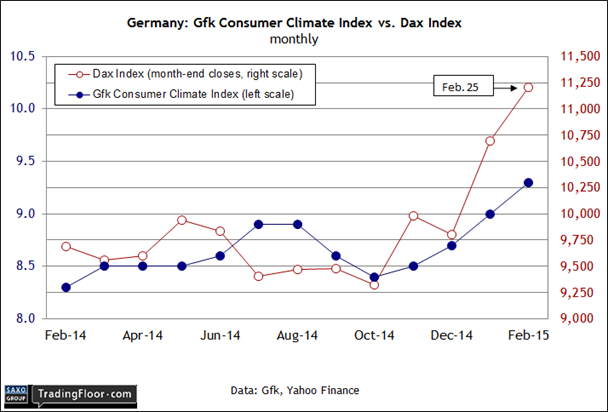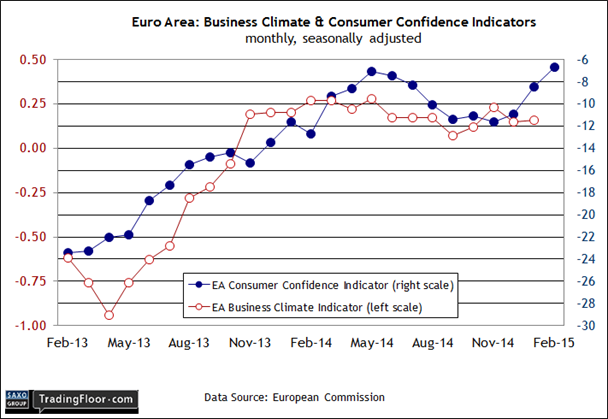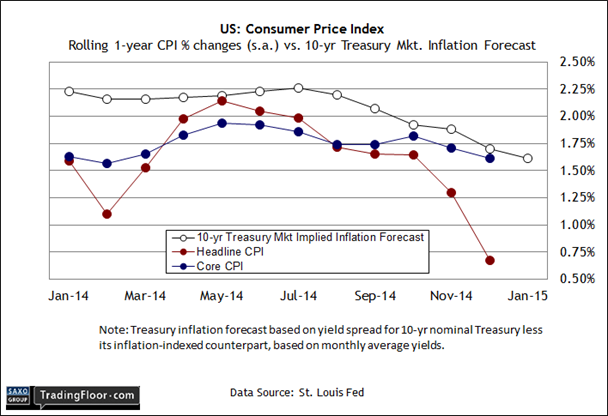- German consumer sentiment continues to improve
- Upside movement expected for the EU's business climate indicator
- US consumer inflation remains soft, ruling out an imminent rate hike
Thursday’s a busy day for economic news. The run of new numbers for Europe starts with Gfk’s updated survey of consumer sentiment in Germany. Later, the European Commission’s measure of the mood in the business sector for the euro area in February arrives, followed by the monthly update on consumer-price inflation in the US.
Germany: Gfk Consumer Climate Index (07:00 GMT) Europe’s main economy is growing at a faster pace, according to recent reports, and today’s numbers are expected to reaffirm the trend. The unemployment report scheduled for release today at 08:55 GMT is the main event (the crowd’s anticipating another round of upbeat figures). But Gfk’s read on consumer sentiment in Germany arrives several hours earlier and so this number will set the tone for the day ahead on European macro matters.
Here as well the tone looks set to improve… again. Using the real-time sentiment metric – aka the German stock market according to the DAX Index – suggests as much. The benchmark closed yesterday at close to a record high, in part because Germany’s economic reports have improved. Expectations for lackluster growth have in recent weeks been revised up to a considerably brighter outlook. It’s worth noting that Mr Market and sentiment measures like Gfk’s benchmark anticipated a revival in the hard data of late. Markit’s business survey data has been improving in recent months as well via the Germany Composite Output Index (COI). Each of the past four monthly COI updates (including last week’s February release) have pointed to stronger growth. Until recently, the consensus view argued otherwise.
Today’s Gfk report, which will “forecast” the index’s level for March, is likely to reflect more of the same. That’s no longer surprising. But recent history tells us to keep a close eye on these sentiment indicators for early clues of a change in trend. For today, however, the theme will likely be one of confirming the-now-widely-accepted view. That won't last forever, of course, but for the moment the sunnier mood via the consensus outlook isn't controversial.
EU: Economic Sentiment (10:00 GMT) Germany’s macro outlook is improving, and so is the trend for the Eurozone. But that’s where the similarities end. The big-picture analysis for the Eurozone has a positive bias again, but the basis for the mildly brighter mood change rests on shaky ground compared with Germany’s revival. Based on the rear-view mirror, however, the recent trend no longer looks hopelessly dire for the Continent overall. There’s still a huge wall of challenges to overcome, but at this stage the details matter less than the general change in trend, if only on the margins.
Once again, sentiment data has been ahead of the consensus, including numbers published by the European Commission’s Consumer Confidence Indicator (CCI). Last week’s flash estimate for February marked the third straight increase for the Eurozone reading.
In addition to today’s revised CCI data, the first look at the Business Climate Indicator (BCI) hits the streets. This measure of expectations from business managers via the BCI has yet to show the upward bias that’s bubbling in the consumer sector and so it’ll be useful to learn if there’s any corroboration (or not) in the new figures.
Even if the EU report brings encouraging news, a bigger question lurks: Is the recent uptick in Eurozone data the genuine article? More analysts are starting to think so, but how much of this is perception vs. reality?
Expectations for Europe have certainly improved, but this looks impressive only by the tortured standards of recent history. Once you move past the relative improvement, the usual suspects – a mix of geopolitical and economic risks – remain. But to some extent perception is reality and so any improvement, however marginal, could be a prelude to a more robust phase of recovery. It’s too soon to tell the difference, but for the moment the tide is turning on the side of growth – precariously so, but that’s still better than the alternative.
One influential voice on Europe’s economic trend is certainly of a mind to see the glass half full. Executive Board member Peter Praet this week said the outlook is brightening. “Spain is growing again; and also in Portugal and in Ireland the situation is improving. In countries with little reform – France and Italy – you see worse results,” he explained. “But we are finalizing our new growth forecasts and there is a big chance that they will be better.”
That’s a clue for thinking that we’ll see a bit of upside movement in the BCI data for February.
US: Consumer Price Index (13:30 GMT) Fed Chair Janet Yellen this week told Congress that rate hikes are still likely, but the timing would be data dependent. We’ve heard that before, but there’s some fresh specificity to consider, as she outlined in her prepared remarks:
"Provided that labour market conditions continue to improve and further improvement is expected, the Committee anticipates that it will be appropriate to raise the target range for the federal funds rate when, on the basis of incoming data, the Committee is reasonably confident that inflation will move back over the medium term toward our two-percent objective."
Hold that thought as we await today’s monthly update on consumer-price inflation. By this gauge, pricing pressures continue to weaken and the 2% objective is nowhere in sight. The annual rate of the consumer price index fell to a slim 0.7% – the lowest since 2010, when the economy was just pulling out of the Great Recession. Core inflation is moderately higher, but here too the trend is softening.
Using the Treasury market yields as a guide, even lesser inflation rates are coming. That’s also the view via the consensus forecast via Econoday.com. Headline CPI is projected to weaken in the monthly comparison for today’s January report: a decline of 0.6% vs. a 0.4% slide in the previous month. Core inflation, on the other hand, is expected to tick up to a mildly positive 0.1% monthly rate.
Weak inflation isn’t a critical problem as long as the broad economy is growing. The upbeat numbers in the labor market are especially helpful for thinking that soft CPI data are due primarily to factors that aren’t immediately threatening to the US macro trend. But for the moment, today’s inflation numbers will likely provide a reminder that the Fed’s still likely to favor later rather than sooner for the timing of the first rate hike.
Disclosure: Originally published at Saxo Bank TradingFloor.com
